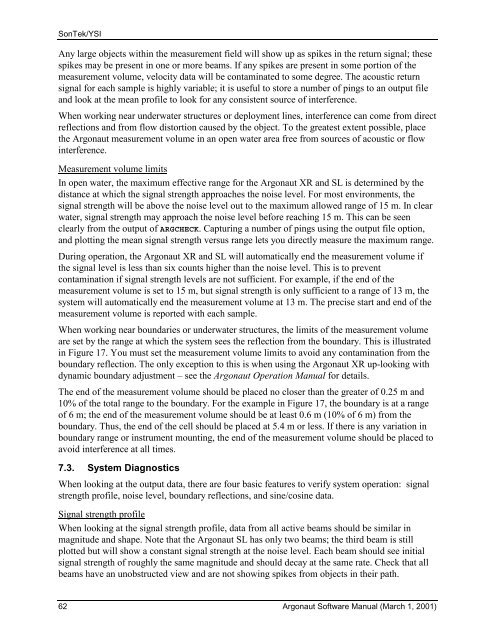SonTek/YSI Argonaut-XR Technical Manual - HydroScientific West
SonTek/YSI Argonaut-XR Technical Manual - HydroScientific West
SonTek/YSI Argonaut-XR Technical Manual - HydroScientific West
Create successful ePaper yourself
Turn your PDF publications into a flip-book with our unique Google optimized e-Paper software.
<strong>SonTek</strong>/<strong>YSI</strong><br />
Any large objects within the measurement field will show up as spikes in the return signal; these<br />
spikes may be present in one or more beams. If any spikes are present in some portion of the<br />
measurement volume, velocity data will be contaminated to some degree. The acoustic return<br />
signal for each sample is highly variable; it is useful to store a number of pings to an output file<br />
and look at the mean profile to look for any consistent source of interference.<br />
When working near underwater structures or deployment lines, interference can come from direct<br />
reflections and from flow distortion caused by the object. To the greatest extent possible, place<br />
the <strong>Argonaut</strong> measurement volume in an open water area free from sources of acoustic or flow<br />
interference.<br />
Measurement volume limits<br />
In open water, the maximum effective range for the <strong>Argonaut</strong> <strong>XR</strong> and SL is determined by the<br />
distance at which the signal strength approaches the noise level. For most environments, the<br />
signal strength will be above the noise level out to the maximum allowed range of 15 m. In clear<br />
water, signal strength may approach the noise level before reaching 15 m. This can be seen<br />
clearly from the output of ARGCHECK. Capturing a number of pings using the output file option,<br />
and plotting the mean signal strength versus range lets you directly measure the maximum range.<br />
During operation, the <strong>Argonaut</strong> <strong>XR</strong> and SL will automatically end the measurement volume if<br />
the signal level is less than six counts higher than the noise level. This is to prevent<br />
contamination if signal strength levels are not sufficient. For example, if the end of the<br />
measurement volume is set to 15 m, but signal strength is only sufficient to a range of 13 m, the<br />
system will automatically end the measurement volume at 13 m. The precise start and end of the<br />
measurement volume is reported with each sample.<br />
When working near boundaries or underwater structures, the limits of the measurement volume<br />
are set by the range at which the system sees the reflection from the boundary. This is illustrated<br />
in Figure 17. You must set the measurement volume limits to avoid any contamination from the<br />
boundary reflection. The only exception to this is when using the <strong>Argonaut</strong> <strong>XR</strong> up-looking with<br />
dynamic boundary adjustment – see the <strong>Argonaut</strong> Operation <strong>Manual</strong> for details.<br />
The end of the measurement volume should be placed no closer than the greater of 0.25 m and<br />
10% of the total range to the boundary. For the example in Figure 17, the boundary is at a range<br />
of 6 m; the end of the measurement volume should be at least 0.6 m (10% of 6 m) from the<br />
boundary. Thus, the end of the cell should be placed at 5.4 m or less. If there is any variation in<br />
boundary range or instrument mounting, the end of the measurement volume should be placed to<br />
avoid interference at all times.<br />
7.3. System Diagnostics<br />
When looking at the output data, there are four basic features to verify system operation: signal<br />
strength profile, noise level, boundary reflections, and sine/cosine data.<br />
Signal strength profile<br />
When looking at the signal strength profile, data from all active beams should be similar in<br />
magnitude and shape. Note that the <strong>Argonaut</strong> SL has only two beams; the third beam is still<br />
plotted but will show a constant signal strength at the noise level. Each beam should see initial<br />
signal strength of roughly the same magnitude and should decay at the same rate. Check that all<br />
beams have an unobstructed view and are not showing spikes from objects in their path.<br />
62<br />
<strong>Argonaut</strong> Software <strong>Manual</strong> (March 1, 2001)


